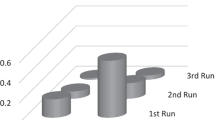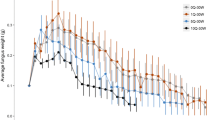Summary
-
1.
Interaction of increasing forager numbers with nurses in a limited living space gave numbers and weight increases comparable to low density cultures in plane nests.
The foraging population included a small but constant number of nurses.
-
2.
Eight living volumes, length 1–8 cm (6 mm diam.) gave no increase of mean foraging population in the 2nd of 2 three-week periods of counting. No noticeable difference, between treatments, or from day to day was shown. An indication of density effect was shown by the two smallest cultures, otherwise the mean brood weight regressing with inside worker number supported a lack of density effect.
-
3.
Eight living volumes, length 0.5–4 cm (4 mm diam.) gave no rapid brood but residual larval numbers regressed with relative available living space.
-
4.
A repeat trial, 0.5–4 cm (4 mm diam.) suggested a change of worker packing with a constant number of residual larvae except in the two smallest cultures.
-
5.
Change of packing was not successfully observed as workers maintained a tight packing pattern throughout, corresponding however to the tightly packed stage of the previous experiment. A constant fall of insiders, 10 workers/cm length was observed.
-
6.
Brood loss in high density cultures seems likely to be caused by worker aggression. Two chewed-up larvae were observed.
-
7.
Interaction of queen effect and high density, caused least weight gain for large, hibernated larvae although high density alone had considerable inhibitory effects.
-
8.
Queen presence and high density had a lesser but definite effect on small hibernated larvae. Losses were greater and weight gains smaller when a queen was present at high density. She has a physical volume equivalent to 3 workers and a «behavioural» presence of the same number and these latter were excluded when space was limited.
Résumé
-
1.
La relation entre le nombre de récolteuses et de nourrices, dans un espace vital limité, donne une augmentation du nombre et poids comparable aux cultures à faible densité dans les nids plans.
Parmi les récolteuses, il y a un nombre petit mais constant de nourrices.
-
2.
Huit cages d'élevage, longueur 1–8 cm (6 mm diam.), ne donnent pas d'augmentation de la population moyenne des butineuses dans la seconde période de comptage de trois semaines. Il n'est pas observé de différences remarquables entre traitements ou d'un jour à l'autre. Une indication de l'effet de densité est montrée par les deux plus petites cultures, autrement le poids moyen du couvain régressant avec le nombre d' ♀ à l'intérieur corrobore l'absence d'effet de densité.
-
3.
Huit cages d'élevage, longueur 0,5–4 cm (4 mm diam.), ne donnent pas de couvain à développement rapide, mais le nombre de larves résiduelles régresse avec l'espace vital relatif disponible.
-
4.
Un nouvel essai, 0,5–4 cm (4 mm diam.), suggère un changement du groupe d' ♀ avec un nombre constant de larves rèsiduelles, sauf dans les deux plus petites cultures.
-
5.
Le changement d'un paquet d' ♀ n'a pas ètè observè avec succès car les ♀ ont maintenant un fort groupement. Tout le temps, correspondant cependant à l'état de groupement étroit de l'expérience précédente. Une chute constante des «individus d'intérieur», 10 ♀, a été observée.
-
6.
Des pertes de couvain dans les cultures à haute densité semblent vraisemblablement dues à l'agression des ♀. Deux larves mâchonnées ont été vues.
-
7.
L'interaction des effets de la reine et de la haute densité produit und moindre gain de poids pour les grandes larves hibernantes, bien qu'une forte densité seule a de considérables effets inhibiteurs.
-
8.
La présence de la reine et une haute densité ont un effet moindre, mais certain, sur les petites larves hibernantes. Les pertes sont plus grandes et les gains de poids plus petits quand une reine est présente à grande densité. Elle occupe un volume physique équivalent à 3 ♀ et une présence «comportementale» du même nombre et ces dernières sont exclues quand l'espace est limitè.
Similar content being viewed by others
References
Brian (M. V.), 1953. — Brood rearing in relation to worker number in the antMyrmica.Physiol. Zool., 26, 355–366.—Brian (M. V.), 1956a. Group form and causes of working inefficiency in the antMyrmica rubra L.Physiol. Zool., 29, 173–194. —Brian (M. V.), 1956b. Studies of caste differentiation inMyrmica rubra L. 4. Controlled larval nutrition.Ins. Soc., 3, 369–394.—Brian (M. V.), 1957. Food distribution and larval size in cultures of the antMyrmica rubra L.Physiol. comp. et oecol., 4, 329–345.—Brian (M. V.), 1958. The evolution of queen control in the social Hymenoptera.Proc. 10th Int. Congr. Entom., 1956,2, 497–502.—Brian (M. V.), 1969. Male production in the antMyrmica rubra L.Ins. Soc., 16, 249–268.
Brian (M. V.) andHibble (J.), 1963. — Larval size and the influence of the queen on growth inMyrmica.Ins. Soc., 10, 71–82.
Weir (J. S.), 1958. — Polyethism in workers of the antMyrmica. II. Conditions in colonies ofM. rubra microgyna.Ins. Soc., 5, 315–339.
Author information
Authors and Affiliations
Rights and permissions
About this article
Cite this article
Kelly, A.F., Stebbings, A.F. High densities and brood rearing in the antMyrmica rubra L.. Ins. Soc 20, 109–123 (1973). https://doi.org/10.1007/BF02223342
Issue Date:
DOI: https://doi.org/10.1007/BF02223342




